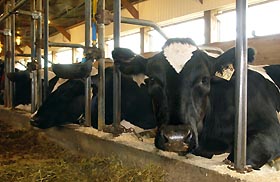|
This is an archived article.
For the latest news, go to the Advance
Homepage
For more archives, go to the Advance Archive/Search Page. |
||
|
Yang's Research May Help Improve
Cloning's Success Rates By David Bauman
The scientists examined the expression patterns of 10 genes on the X chromosomes in nine full-term clones (four alive and five dead) and one aborted fetus cloned from one of the clones. All these clones were created by nuclear transfer using different somatic cells of an aged Holstein cow. They found abnormal gene expression in the major organs including heart, liver, brain, kidney and spleen of all dead clones, while live clones appear to have normal gene expressions in their blood and skin tissues. The research focused on how cells interpret their genetic instructions. It sheds new light on why cloning by somatic cell nuclear transfer suffers from low success rates. The findings also raise questions about how cloned cows can develop to full term despite the problems of abnormal gene expression in their organs. "Our study demonstrates that in clones, even though they can develop to full term, many abnormalities in gene expression exist which may be partially responsible for the developmental abnormalities frequently observed, including death," says Professor Xiangzhong (Jerry) Yang, lead author of the article and director of UConn's Center for Regenerative Biology. The study demonstrates that cloning is a still-maturing technology, according to Thomas Wagner, a professor of molecular biology at Clemson University. "Dr.Yang's study clearly shows that cloning, like any biotechnology, needs to be perfected," he says. "His results identify a specific reason why it doesn't always work and offer a means to make modifications in the procedure to correct the problem." Many cloned mice, cows, goats and pigs have been born since Scottish scientists cloned the first sheep, Dolly, in 1997. Yet it takes dozens, sometimes hundreds, of attempts to succeed. Few clones are long-term survivors: 80 percent die during pregnancy or soon after birth from defects, suggesting that during embryonic and fetal development the genes did not work properly. The "gene expression" investigated in Yang's new study is a process in which cells use only parts of their genetic codes to accomplish their special function. Although different kinds of cells such as skin, muscles, and nerves all contain the entire DNA "instruction book" for creating, say, another cow, the only part of their DNA that becomes active is that which turns on the genes that determine what kind of cells they become. Once a cell has taken on its specialized role, many of the other genes in the cell become inactive. During cloning, when any single cell is transferred into a donor egg cell that has been emptied of its own DNA, the inactive genes in the donor nucleus are quickly reprogrammed and become once again able to set off development of a new animal. Yang's study suggests that abnormalities seen in cloned cattle may stem from faulty or incomplete "reprogramming" of a cell's nucleus. During this crucial step, after the DNA is transferred from a differentiated cell into an egg cell that has no DNA of its own and the reconstructed egg cell begins to reset the gene expression of the injected DNA, something goes awry. The study also found that different types of donor cells could affect cloning efficiency and clone viability. Yang says further understanding of the abnormal gene expressions in clones may set a theoretical basis for designing better cloning protocols for the development of healthy clones. |
 esearch reported by UConn scientists in the May 21 issue of
the journal Nature Genetics suggests that abnormal
expression of genes in the organs of cloned cows may explain why so
many cloned pregnancies fail and why some cloned animals suffer
medical problems and death soon after birth.
esearch reported by UConn scientists in the May 21 issue of
the journal Nature Genetics suggests that abnormal
expression of genes in the organs of cloned cows may explain why so
many cloned pregnancies fail and why some cloned animals suffer
medical problems and death soon after birth.
